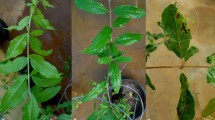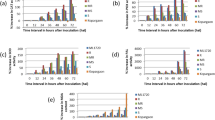Abstract
Bacterial blight is a highly devastating disease caused by Xanthomonas axonopodis pv. punicae, recording 60 to 80 percent yield-loss of pomegranate in India. In the present investigation, a total of 209 genotypes including 105 exotic types from USDA, 66 wild types and 38 cultivated types from India were screened and categorized into fifteen clusters using cluster and principal component analysis. Genotypes of cluster 15, viz. 108 B and 99 A from USDA and 318734, Daru-18 and IIHR-30 from India, were found to be resistant to bacterial blight while genotypes of cluster 9 were highly susceptible. Two genotypes, each from cluster 15 (318734) and 9 (Ruby), were compared for biochemical and histological parameters to understand the defense mechanism. Significantly, higher accumulation of defense related metabolites, viz. total phenol, flavonoid and antioxidant contents, were observed in resistant genotype (318734). Fewer numbers of stomatal pores that served as portals of entry for plant pathogens were recorded in this genotype. Resistance observed in genotype 318734 might be due to an incompatible interaction between host and pathogen compared to other genotypes. This is the first report of putative resistance sources in pomegranate against Xanthomonas axonopodis pv. punicae.







Similar content being viewed by others
References
Altschul, S. F., Madden, T. L., Schaffer, A. A., Zhang, J., Zhang, Z., Miller, W., et al. (1997). Gapped BLAST and PSI-BLAST: a new generation of protein database search programs. Nucleic Acids Research, 25(17), 3389–3402.
Anonymous (2014). Area and Production. http://www.NHBdatabase.com.
Ashry, N. A., & Mohamed, H. I. (2011). Impact of secondary metabolites and related enzymes in flax resistance and susceptibility to powdery mildew. World Journal of Agricultural Sciences, 7, 78–85.
Benagi, V. I., & Kumar, R. M. R. (2009). Present status of pomegranate bacterial blight and its management. “In: 2 nd international symposium on pomegranate and minor including mediterranean fruits” at UAS, Dharwad (pp 53–58) from 23/6/09 to 27/6/09.
Benzie, I. F. F., & Strain, J. J. (1996). The ferric reducing ability of plasma (FRAP) as a measure of antioxidant power: The FRAP assay. Analytical Chemistry, 239, 70–76.
Brown, M. V., Mooi, J. N., Fenn, P., & McNew, R. W. (1999). Comparison of leaf disk, greenhouse, and field screening procedures for evaluation of grape seedlings for downy mildew resistance. HortScience, 34(2), 331–333.
Chand, R., & Kishun, R. (1993). Systemic movement of Xanthomonas campestris pv. punicae (Hingorani and Singh) dye from leaf to node in pomegranate. International Journal of Tropical Plant Diseases, 11(1), 85–90.
Chun, O. K., Kim, D. O., Moon, H. Y., Kang, H. G., & Lee, C. Y. (2003). Contribution of individual polyphenolics to total antioxidant capacity of plums. Journal of Agricultural and Food Chemistry, 51, 7240–7245.
Clarridge, J. E. (2004). Impact of 16S rRNA gene sequence analysis for identification of bacteria on clinical microbiology and infectious diseases. Clinical Microbiology Reviews, 17(4), 840–862.
Dahima, V., Sharma, S. S., Khokhar, M. K., & Hooda, K. S. (2014). Post-infectional biochemical changes in maize leaves affected by banded leaf and sheath blight disease. Indian Phytopathology, 67(4), 370–373.
Ensikat, H. J., Ditsche-Kuru, P., & Barthlott, W. (2010). Scanning electron microscopy of plant surfaces: simple but sophisticated methods for preparation and examination. In Microscopy: Science, technology, applications and education (pp. 248–255). Spain: Formatex.
Flor, H. H. (1956). The complementary genic system in flax and flax rust. Advances in Genetics, 8, 29–54.
Gargade, V. A., & Kadam, D. G. (2015). In vitro evaluation of antibacterial potential of Pongamia pinnata L. against Xanthomonas axonopodis punicae, phytopathovar of bacterial blight of pomegranate (Punica granatum). International Journal of Current Microbiology and Applied Sciences, 4(5), 824–833.
Gopalakrishnan, C., Saxena, A. K., & Keerthishree, S. P. (2009). Simple technique for screening pomegranate hybrids for resistance to bacterial blight disease. “International conference on plant pathology in the Global Era” at IARI, New Delhi from 10/11/09 to 13/11/09.
Graham, J. H., Gottwald, T. R., Riley, T. D., & Anchor, D. (1992). Penetration through leaf stomata and growth of strains of Xanthomonas campestris in citrus cultivars varying in susceptibility to bacterial diseases. Phytopathology, 82, 1319–1325.
Gupta, S., Mallick, S. A., & Gupta, M. (2010). Role of oxidative enzymes and biochemical constituents in imparting resistance to French bean varieties against bean anthracnose. Indian Phytopathology, 63(1), 47–50.
Hingorani, M. K., & Mehta, P. P. (1952). Bacterial leaf spot of pomegranate. Indian Phytopathology, 5, 55–56.
Holland, D., & Bar-Ya’akov, I. (2014). Pomegranate: aspects concerning dynamics of health beneficial phytochemicals and therapeutic properties with respect to the tree cultivar and the environment. In Medicinal and aromatic plants of the Middle-East (pp. 225–239). Berlin: Springer.
Jalikop, S., Rawal, R., & Kumar, R. (2005). Exploitation of sub-temperate pomegranate Daru in breeding tropical varieties. Acta Horticulturae, 696, 107–112.
Jiang, Y. F., Cheng, W. D., Qin, L. Q., Tan, X. J., Zhou, J. G., Xie, H. X., et al. (2009). Physiological mechanism of exogenous salicylic acid induced resistance to sheath blight of maize (Zea mays L.). Guangxi Agricultural Sciences, 40, 242–245.
Kale, P. B., Chimote, V. P., Raghuwanshi, K. S., Kale, A. A., Jadhav, A. S., & Borkar, S. G. (2012). Microbial, biochemical, pathogenicity and molecular characterization of Xanthomonas axonopodis pv. punicae from pomegranate. Journal of Pure and Applied Microbiology, 6(4), 1699–1706.
Kang, H. M., & Saltveit, M. E. (2002). Antioxidant capacity of lettuce leaf tissue increases after wounding. Journal of Agricultural and Food Chemistry, 50, 7536–7541.
Kim, S. G., Kim, Y. H., Kim, H. T., & Kim, Y. H. (2008). Effect of delayed inoculation after wounding on the development of anthracnose disease caused by Colletotrichum acutatum on chili pepper fruit. Plant Pathology Journal, 24(4), 392–399.
Kumar, R., Shamarao, J. M. R., Yenjerappa, S. T., & Patil, H. B. (2009). Epidemiology and management of bacterial blight of pomegranate caused by Xanthomonas axonopodis pv. punicae. Acta Horticulturae, 818, 291–296.
Melotto, M., Underwood, W., & He, S. Y. (2008). Role of stomata in plant innate immunity and foliar bacterial diseases. Annual Review of Phytopathology, 46, 101–122.
Mondal, K. K., & Kumar, A. (2011). Advances in phenomics, genomics and diagnostics of Xanthomonas axonopodis pv. punicae causing bacterial blight of pomegranate. In: Practical manual. IARI, New Delhi.
Mondal, K. K., & Sharma, J. (2009). Bacterial blight: An emerging threat to pomegranate export. Indian Farming, 59, 22–23.
Mondal, K. K., Rajendran, T. P., Mani, C., Sharma, J., Shukla, R., Pooja, et al. (2012). The reliable and rapid polymerase chain reaction (PCR) diagnosis for Xanthomonas axonopodis pv. punicae in pomegranate. African Journal of Microbiology Research, 6(30), 5950–5956.
Panse, V. G., & Sukhatme, P. V. (1985). Statistical methods for agricultural workers (4th ed.,) (p. 47). New Delhi: ICAR.
Pawar, M., Kadam, M., & Nirichan, B. K. (2014). In vitro control of bacterial blight causing organism (Xanthomonas axonopodis pv. punicae) of pomegranate. Journal of Environmental Research and Development, 8(3A), 568–573.
Pearson, K. (1901). On lines and planes of closest fit to systems of points in space. Philosophical Magazine, 6, 559–572.
Petersen, Y., Mansvelt, E. L., Venter, E., & Langenhoven, W. E. (2010). Detection of Xanthomonas axonopodis pv. punicae causing bacterial blight on pomegranate in South Africa. Australasian Plant Pathology, 39, 544–546.
Prajongjai, T., Poolsawat, O., Pombungkerd, P., Wongkaew, S., & Tantasawat, P. A. (2014). Evaluation of grapevines for resistance to downy mildew (Plasmopara viticola) under laboratory and field conditions. South African Journal of Enology and Viticulture, 35(1), 43–50.
Przybyla, A. A., Bokszezanin, K. L., Schollenberger, M., Gozdowski, D., Madry, W., & Odziemkowski, S. (2012). Fire blight resistance of pear genotypes from different European countries. Trees, 26, 191–197.
Ramos, I. J., & Volin, R. B. (1987). Role of stomatal opening and frequency on infection of Lycopersicon spp. by Xanthomonas campestris pv. vesicatoria. Phytopathology, 77, 1311–1317.
Reddy, M. R. S. (1997). Sources of resistance to bacterial canker in citrus. Journal of Mycology and Plant Pathology, 27(1), 80–81.
Sharma, K. K., Sharma, J., & Jadhav, V. T. (2010). Status of bacterial blight of pomegranate in India. In: Fruit, vegetable, cereal science and biotechnology (special issue 2) (pp. 102–105). Japan: Global Science Books (pub.).
Shukla, S. N., & Gangopadhyaya, S. (1981). Stomatal index and size of stomatal opening in rice cultivars varying in reaction to bacterial leaf blight. Proceedings of the Indian National Science Academy, B47(4), 557–559.
Singh, N. V., Abburi, V. L., Ramajayam, D., Kumar, R., Chandra, R., Sharma, K. K., et al. (2015). Genetic diversity and association mapping of bacterial blight and other horticulturally important traits with microsatellite markers in pomegranate from India. Molecular Genetics and Genomics, 290(1), 1–10.
Singleton, V. L., & Rossi, J. A. (1965). A colorimetry of total phenolics with phosphomolybdic-phosphotungstic acid reagents. American Journal of Enology and Viticulture, 16, 144–158.
Srinivasa, C., Sharanaiah, U., & Shivamallu, C. (2012). Molecular detection of plant pathogenic bacteria using polymerase chain reaction single-strand conformation polymorphism. Acta Biochimica et Biophysica Sinica, 44(3), 217–223.
Susheela, K. (2012). Evaluation of screening methods for anthracnose disease in chilli. Pest Management in Horticultural Ecosystems, 18(2), 188–193.
Tamura, K., Dudeley, J., Nei, M., & Kumar, S. (2007). MEGA4: Molecular evolutionary genetics analysis (MEGA) software version 4.0. Molecular Biology and Evolution, 24, 1596–1599.
Teixeira da Silva, J. A., Rana, T. S., Narzary, D., Verma, N., Meshram, D. T., & Ranade, S. A. (2013). Pomegranate biology and biotechnology: a review. Scientia Horticulturae, 160, 85–107.
Thompson, J. D., Gibson, T. J., Plewniak, F., Jeanmougin, F., & Higgins, D. G. (1997). The CLUSTAL_X windows interface: flexible strategies for multiple sequence alignment aided by quality analysis tools. Nucleic Acids Research, 25, 4876–4882.
Vauterin, L., Hoste, B., Kersters, K., & Swings, J. (1995). Reclassification of Xanthomonas. International Journal of Systematic Bacteriology, 45, 472–489.
Verniere, C., Hartung, J. S., Pruvost, O. P., Civerolo, E. L., Alvarez, A. M., Maestri, P., et al. (1998). Characterization of phenotypically distinct strains of Xanthomonas axonopodis pv. citri from Southwest Asia. European Journal of Plant Pathology, 104, 477–487.
Wang, J. Y., Zhu, C., Qian, T. W., Guo, H., Wang, D. D., Zhang, F., et al. (2015). Extracts of black bean peel and pomegranate peel ameliorate oxidative stress-induced hyperglycemia in mice. Experimental and Therapeutic Medicine, 9(1), 43–48.
Ward, J. H. (1963). Hierarchical groupings to optimize an objective function. Journal of the American Statistical Association, 58, 236–244.
Acknowledgments
The authors are thankful to Director, Indian Institute of Horticultural Research (IIHR), Bengaluru, for providing research facilities and funding the above research work. Special thanks are due to Dr. K. Hima Bindhu for critical editing of the manuscript.
Author information
Authors and Affiliations
Corresponding author
Rights and permissions
About this article
Cite this article
Priya, B.T., Murthy, B.N.S., Gopalakrishnan, C. et al. Identification of new resistant sources for bacterial blight in pomegranate. Eur J Plant Pathol 146, 609–624 (2016). https://doi.org/10.1007/s10658-016-0947-1
Accepted:
Published:
Issue Date:
DOI: https://doi.org/10.1007/s10658-016-0947-1




